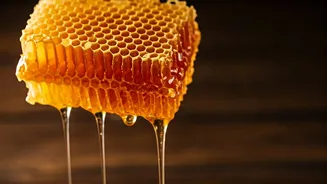The Water Test
One of the easiest ways to test honey's purity involves a simple water test. Take a glass of water and add a spoonful of honey. If the honey is pure, it should
sink to the bottom of the glass and remain there. Adulterated honey, often mixed with water or other substances, will dissolve in the water. This indicates it is not pure, as pure honey is denser and should retain its form when immersed. By observing this simple reaction, you can make an initial assessment of the honey's quality without any special equipment.
The Thumb Test
The thumb test offers a quick visual and textural assessment of honey. Put a drop of honey on your thumb. If the honey remains intact, without spreading or running, it likely is pure. However, if the honey spreads quickly, runs, or spills, it can suggest that the honey may contain added water or sweeteners. The thickness and viscosity of pure honey contribute to this characteristic. This simple, hands-on test provides an instant indicator of honey quality.
The Flame Test
This is another straightforward way to detect honey adulteration, employing the use of a matchstick. Dip a dry matchstick into the honey, then attempt to strike the match. If the honey is pure, the match should ignite. The high sugar content and lack of water in pure honey allow for quick ignition. If the match fails to light, or struggles to do so, it might signal that the honey is not pure. Added water or other adulterants can hinder the match's ignition. It is simple to execute and a reliable indicator.
The Paper Test
To conduct the paper test, place a drop of honey onto a piece of blotting paper or a clean paper towel. Pure honey should maintain its consistency and not be absorbed by the paper. The paper will remain dry. Honey with additives often contains water, which will be absorbed, leaving a wet spot on the paper. The absence of absorption confirms the density and purity of the honey sample. Observe the paper for any signs of liquid seeping, to check for any adulteration.
The Crystalization Test
Pure honey naturally crystallizes over time due to its glucose content. If your honey starts to crystallize, it is a good sign. However, the speed of crystallization may depend on the honey's variety and storage conditions. If the honey remains liquid, it could be a sign of adulteration, as additives might prevent natural crystallization. Keep in mind that honey stored in cooler temperatures will crystallize faster. This test provides a long-term insight into honey's purity. Observing the crystallization process can reveal how the honey behaves over time.
Taste and Smell
Your senses can provide valuable clues about honey's authenticity. Pure honey has a unique aroma and taste, varying slightly depending on its floral source. Adulterated honey might have an artificial flavour or a different aroma. A diluted honey will often be less potent in taste and scent, while a honey that has been cut with corn syrup will taste more sugary. If the taste or smell feels off, there is a possibility that it is adulterated. Tasting and smelling honey allows for a direct assessment of its composition. Try multiple brands.












